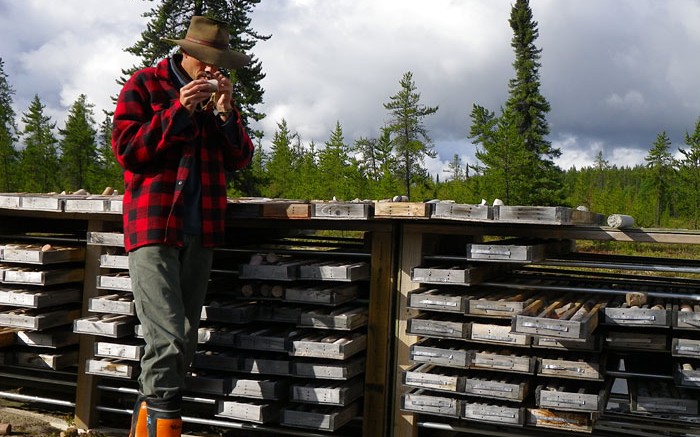VANCOUVER — Though junior Azincourt Uranium (TSXV: AAZ; US-OTC: AZURF) is a relatively new arrival to the exploration game — the company completed its listing prospectus in April 2012 — it has made waves by locking down a piece of the highly prospective Patterson Lake camp in Saskatchewan’s Athabasca basin, via an option agreement with accomplished explorer Fission Uranium (TSXV: FCU; US-OTC: FCUUF).
When The Northern Miner spoke with Azincourt president and CEO Ted O’Connor in mid-August, he made it clear that acquisition opportunities were a priority. O’Connor talked about searching for projects with in-situ uranium resources, and it looks like Azincourt has found a fit with two South American assets.
On Nov. 22, the company announced it had entered into a definitive share-purchase agreement with joint-venture partners Cameco (TSX: CCO; NYSE: CCJ) and Vena Resources (TSX: VEM) to acquire full ownership of the resource-stage Macusani and earlier-stage Munani exploration projects in southeastern Peru’s Puno department.
Under the agreement, Cameco and Vena would each receive $1 million, comprised of 2.5 million shares valued at $750,000, plus a $250,000 cash payment. Share valuations were based on Azincourt’s volume-weighted average trading price over the 10 trading days before signing. Vena’s chairman and CEO Juan Vegarra will also join Azincourt’s board as an independent director.
O’Conner, who served as Cameco’s vice-president of corporate development, says during a phone interview in November that he recommended that the company get involved after visiting the projects in 2006. “I ended up negotiating the deal and managing the project, so I have some very good familiarity with the work that has already been done there, as well as the surrounding area.”
Macusani has seen $12 million in exploration, and is comprised of nine non-contiguous mineral concessions covering 49 sq. km. The project lies 650 km southeast of Lima, and 230 km by road north of the city of Juliaca. Uranium mineralization at Macusani is hosted in ignimbritic volcanic rhyolites, and is found in fractures and as disseminated crystals within distinct zones.
The project has partly defined resources based on 38,000 metres of drilling. Measured resources total 9.3 million tonnes grading 0.025% uranium oxide (U3O8) for 5.7 million contained lb. U3O8,while indicated resources tack on 31 million tonnes averaging 0.018% U3O8 for 12.5 million contained lb. Inferred resources add another 34 million tonnes grading 0.02% U3O8 for 17.4 million contained lb.
“There are a lot of resources identified at the project that are shallow, with less than a 3-to-1 strip ratio. It certainly isn’t high grade by any stretch, but that’s really typical of uranium deposits in the area,” O’Connor says, mentioning that Macusani Yellowcake’s (TSXV: YEL; US-OTC: MCYWF) resource-stage uranium assets are nearby.
“It’s really about geology and economics . . . the high grades you get in the Athabasca are great, but they’re high-cost mining and processing operations. The work that’s been done on the mineralization to date point to it being inexpensive processing. So even at low grades, it looks like it will have decent economics,” he says.
Munani is 96 sq. km east of the town of Crucero, and hasn’t seen drilling. Previous fieldwork included regional scintillometre prospecting and radon surveys, plus detailed geological mapping, sampling and limited trenching. Uranium mineralization has been found in sandstone and intermediate volcanic-rock outcrops, with targets prioritized for future drilling.
Meanwhile, Azincourt and Fission are advancing towards an inaugural 3,000-metre drill program at the Patterson Lake North (PLN) joint venture in the Athabasca basin. The companies reported on Nov. 18 that 10 targets have been identified, with the program aimed at testing a northwest-trending central conductive meta-sedimentary belt, as well as geophysical anomalies under Hodge Lake. Fission acts as operator at the project, with Azincourt funding US$1.5 million in exploration this year under its earn-in agreement.
Azincourt reported $1.6 million in working capital at the end of June, and has traded within a 52-week window of 8¢ and 35¢, on average trade volumes of 652,230 shares per day. At press time the company closed at 28.5¢, and maintains 28 million shares outstanding for an $8-million market capitalization.
“We’re always on the lookout for opportunities,” O’Connor says. “Since our PLN releases and geophysical success, our stock has been trading well. We’re trying to grow the company with real ‘uranium-in-the-ground’ assets, and I think we’ve delivered with our deal in Peru. Now that we’ve done that, the quality of people and projects in discussion has gone up, because they know we’re serious. When geology and economics come together, you’ll find us there.”


Be the first to comment on "Azincourt CEO talks Peruvian uranium acquisitions"